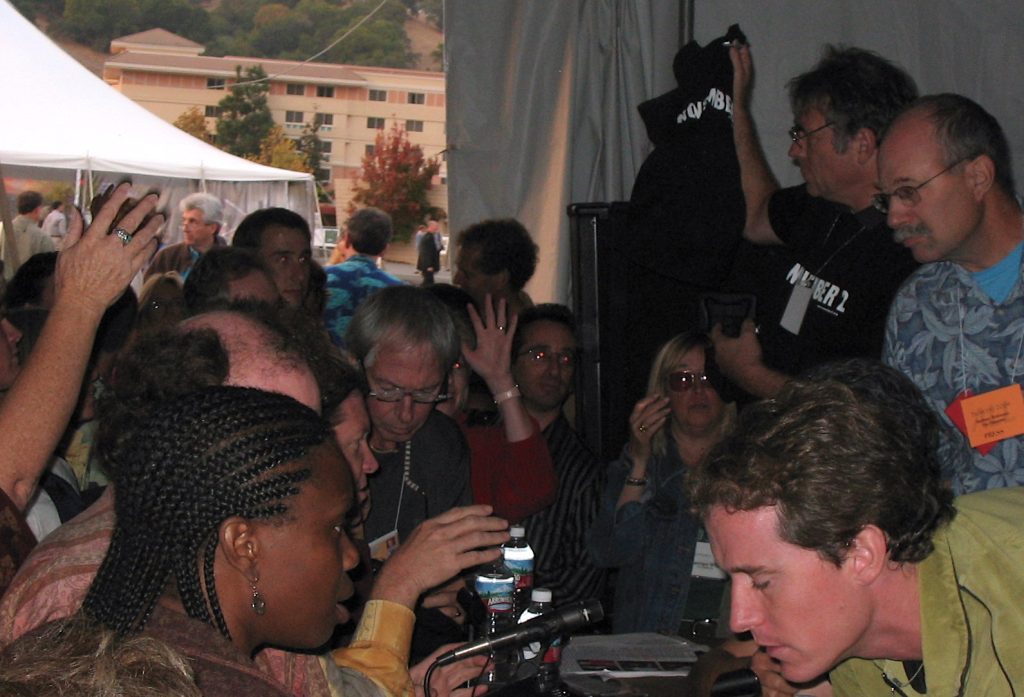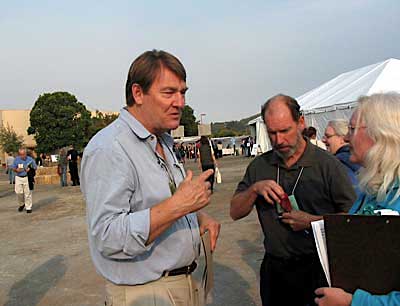Below the sound bite is a report from the annual Bioneers conference in California (San Rafael, Marin Civic Center, October 15-17 2004)
I went to cover the event for our newsletter and website at ICIS Center in Hornbæk whom I worked for 2003-5 (Karen Blincoe‘s International Centre for Creativity Innovation and Sustainability)
This agenda felt even the more pressing as the presidential election in 2004 was just a few weeks away and thus the grim perspective of a Bush reelected with his lack of interest in green matters beyond the Green Zone in Baghdad. Media attention and activism around the conference was perhaps for this reason in even higher gear than in previous years:

Peter Schurman of MoveOn offered razor sharp advice to anybody in the audience asking for advice on strategic communication, or the tactics of social action.
In the background, November 2 election t-shirts are handed out by documentary filmmaker Earl Katz. Internet-based media were at the forefront when discussing “Transformational Innovations in Progressive Media” which also featured Don Hazen of AlterNet.
Amy Goodman of Democracy Now received this question from the audience:
(to which she replied within reach of my microphone)
“Amy, what advice would you give to the next generation of journalists?”

BIONEERS 2004
REPORT FROM MARIN:
Bioneers Conference in California
October 15-17, 2004
Silence and dynamics
Intense drumming called people to the huge auditorium of the Marin Civic Centre, just north of San Francisco where Bioneers held its 15th anniversary conference in mid-October. Drummers initiated the plenary talks, and the audience stormingly applaused high-profile speakers including Amy Goodman (Democracy Now), Rocky Mountains Institute director Amory Lovins, and Candace B. Pert of Georgetown University, DC, cheered for her work on developing inexpensive, non-toxic drugs in the battle against AIDS. But the uniting metaphor of this anniversary conference was – silence. Not in the metaphorical sense, that the audience in any sense held its breath while awaiting the outcome of the November presidential election. But silence does have a special meaning in most parts of the US where the noise from fans, tv and radio stations seems inescapable.
Rather than maintaining and upholding silence, Goodman urged the US media and especially grassroots news networks representatives “to go where the silence is,” and to break it. Jay Harman of California told of how his innovative work in ‘biomimickry’ – spending extended periods of time in nature, when he watches its mechanisms at work, and shared with the audience how he actually creates biomimicking designs based on observations and inner reflection during such stays. John Mohawk laid out pre-christian, Indian thought when he stated: “You don’t have to be a believer, it’s not about faith, but you have to be an appreciator – you have to be there.”
Democracy and Environment
Environmental issues never went high on the US presidential election agenda in the Fall. But congressional and local elections brought the issue to attention regionally throughout in the country, and thousands of enthusiastic followers attended the 15th Bioneers conference in San Rafael, California.
Not that the conference was covered on national television or newspapers. But Bioneers this year arranged satellite transmissions of its four-hour morning sessions to 14 cities in the US, as well as to Vancouver, Canada, all hosting independent conferences on sustainability and the environment. Bioneers is based in New Mexico but organizes its annual conference in northern California where it sells out fairly quickly every year, and with large numbers of people interested in sustainability – and where the time zone is ideal for serving the rest of the continent through satellite-beamed transmissions. When it’s morning in California, it’s daytime in the rest of the country.
Kenny Ausubel, founder of Bioneers, opened a morning presentation with the remark that “information is the currency of democracy”. The absence of information leaves big holes in the consciousness of decision-makers as well the wider population trying to understand the implications of such a thing as stem-cell research (which finally entered the political debates and showed democrats and republicans to agree and disagree on this subject across party-lines).
In the perhaps ‘American’ way, these morning plenaries took issue with the world’s greatest problems, including AIDS in Africa, War on Terror, GMO and other agricultural techniques, and not least what the legendary Rocky Mountains Institute director Amory Lovins termed the Oil-end-game.
Typical of the talks offered, Lovins didn’t just present the problems but offered a clear economic picture and an innovative technological perspective of dealing with the enormous problems the globe as well as our economies are facing, due to our continued reliance on fossil fuel burning. In an afternoon session with Jay Harman on biodesigned solutions to such problems, Lovins finally hinted that his Orangutang friends may be wiser than we are, in the end games – showing videos to the amusement and great surprise of an audience overwhelmed by the communication programs going on with Orangutangs and Bonopos. Harman’s ‘biomimicking’ impeller has already been proven to enhance the efficiency of such devices and could probably reduce the world’s future energy spending by simply mimicking the pattern of spiral pattern of water in motion. Something which even an ape could have thought of, one thinks after Lovins exemplified his communication with the Bonopos.
(www.apeinitiative.org)
The farming battle
Bill Joy was indeed quoted by speakers for his analysis in Wired magazine that we’re seeing a shift from WMD to TMD – Techniques of Mass Destruction, including bio- and nano-technologies. But otherwise the biotech theme was surprisingly absent at the conference, despite Kenny Ausubel’s remarks in a pre-conference newsletter, on the importance of biology and biotech in the future.
The biotech agenda became mostly a farming issue and was rather set by those local Marin voter booth activists outside the building – urging attendees to sign up for a ban on GMO crops in Marin County north of San Francisco, and just south of Mendocino County which has imposed the first ban on GM crops in the United States. Small Mendocino farmers have teamed up with major wine growers like Fetzer Vineyards in order to raise the local ban on GMO.
Jason Clay, vice president of WWF’s Center for Conservation Innovation, offered a world tour of “better farming practices”, whereas attorney Thomas Linzey brought the conferences attention to legal battles fought by farmers in various parts of the US – fighting to prevent the agro-business from owning farms, something which South Dakota among others, have already written into the state constitution.
Thomas Linzey suggested that if nature had its own rights made constitutional, the agrobusiness would be able to act much less aggressively. The roof lifted when Linzey hammered home his point: “There once was a time when people in this country were property!”
The issue sheds interesting light on the situation in e.g. Denmark where farmers traditionally tend to own the agrobusiness in farming cooperatives that look more like corporations than cooperatives these days.

Bioneers ultimately aim at combining the personal level, the individual, with the global challenges – it really doesn’t help us to have all these great alternative designs and technologies available, if the individual isn’t willing to change habits and look to new solutions, and perhaps pay a little more and make some sacrifices.
Beaming Bioneers
The Bioneers conference is a vitamin shot to individuals and networks set up during the conferences. The conference also seems to be a communication tool of growing importance – more than a hundred cities throughout the world have asked for satellite-beaming of next year’s conference. It is easy to imagine a much larger audience for the Bioneers and its very diverse conference program, in itself an illustration of the basic concerns of the Bioneers – biodiversity and sustainability, taking into account a wide array of themes in a program that was impossible for any single individual to take in, with its many subjects, parallel sessions, film screenings, etc.
On a critical note, some of the largest among current challenges received little attention at the conference. Despite Kenny Ausubel’s remarks in a pre-conference newsletter, on the importance of biology and biotech in the future, the theme was surprisingly absent during the conference.
As a European, the question finally arises: with all that energy, imagination and enthusiasm, why is it that it was not the US but rather its old proponent, Russia, that signed the Kyoto protocol in October? One of the answers was given by Martha Arguella (www.psr-la.org), when she pointed out the dilemmas of difficult priorities and hard decisions when she talked about her community-centred work in southern California, not least in fighting air pollution in impoverished urban areas. Arguella’s message to a still applauding audience was the following: “It’s not readable that a local community should sacrifice its air quality so that we can say we’re part of a global emissions program.”

EXTRA: Jay Harman, CEO of PaxScientific, explains details of his principle of design using fluid dynamics. Aero-engineers, marine engineers and numerous others in an afternoon tent audience questioned him about the simple principle of reducing mechanical friction in all sorts of devices – including his impeller already in function.
Nature is always in motion, and Jay Harman’s screw design mimics the vortex spiral pattern of water in motion which always knows how to find the easiest way. Something which has already been proven to enhance the efficiency of ship propellers significantly, but which has also been able to mix large volumes of water and other fluids very fast and with much less energy spent.
PaxScientific licenses its patented designs to companies that want to make applications with the principle. The possible applications are unending in our rational age of computers that allow engineers to calculate and apply these vortex structures to such things as fans (prospect of 10-40% energy reduction) and many other industrially designed devices. On the other hand, Harman explains with a big smile, it may be the ultimate rationality of our age which has actually prevented anyone from exploring the principle of fluid dynamics to such ends before – it works, but in principle birds shouldn’t be able to fly given their structure, and he promises that the principle is to be documented in print in the near future.
Until then: www.paxscientific.com
// END
GSEARCH.ONE
PS. Wondering about Biomimickry?
Bioneers.org should be a place to go look for it then…. so what happens when you search their site for this marvellous concept/term?
NOTHING (click and see)
Means nothing there? Nope – click here instead and see the search results for Biomimickry on bioneers.org but via a free “site search” web app (GSEARCH.ONE – searches in files too)
USE GSEARCH.ONE IF YOU LIKE:
It’s based on Google but doesn’t show you thousands of results – yet they are listed with thumbnails and date sorted when you prefer (and like users all over the world already prefer, free to add https://gsearch.one to any mobile homescreen)

See it on video if you’ve got a minute (and/or read more)
What’s worse: website with no search box at all (like this one) or site search enabled in a way which still doesn’t show you what’s on their website – but makes you believe it does?
I know my answer to the question: Gsearch.One was created to meet that need.
Read more
